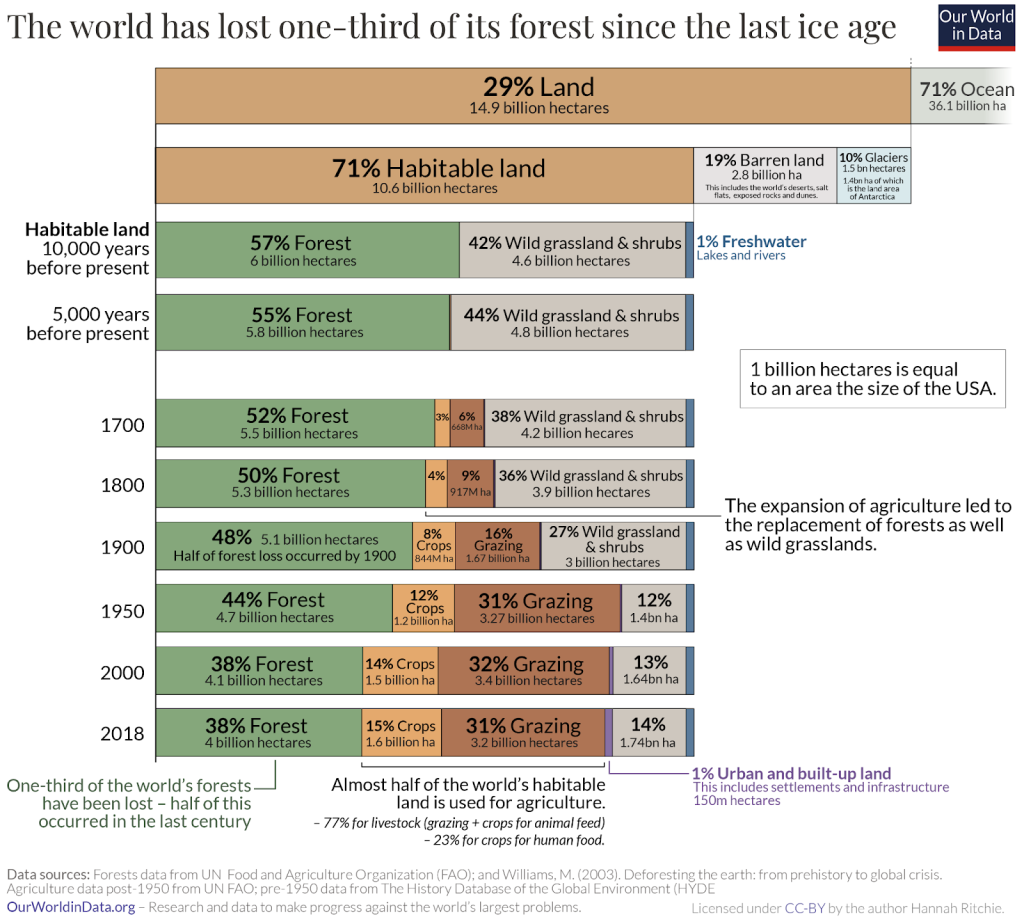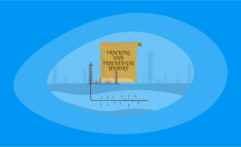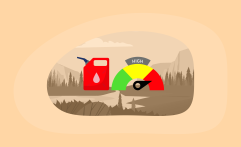Afforestation Carbon Offsets Explained: All You Need to Know
Impactful Ninja is reader-supported. When you buy through links on our site, we may earn an affiliate commission.
Learn more
Learn more
.
Hey fellow impactful ninja ? You may have noticed that Impactful Ninja is all about providing helpful information to make a positive impact on the world and society. And that we love to link back to where we found all the information for each of our posts. Most of these links are informational-based for you to check out their primary sources with one click. But some of these links are so-called "affiliate links" to products that we recommend. First and foremost, because we believe that they add value to you. For example, when we wrote a post about the environmental impact of long showers, we came across an EPA recommendation to use WaterSense showerheads. So we linked to where you can find them. Or, for many of our posts, we also link to our favorite books on that topic so that you can get a much more holistic overview than one single blog post could provide. And when there is an affiliate program for these products, we sign up for it. For example, as Amazon Associates, we earn from qualifying purchases. First, and most importantly, we still only recommend products that we believe add value for you. When you buy something through one of our affiliate links, we may earn a small commission - but at no additional costs to you. And when you buy something through a link that is not an affiliate link, we won’t receive any commission but we’ll still be happy to have helped you. When we find products that we believe add value to you and the seller has an affiliate program, we sign up for it. When you buy something through one of our affiliate links, we may earn a small commission (at no extra costs to you). And at this point in time, all money is reinvested in sharing the most helpful content with you. This includes all operating costs for running this site and the content creation itself. You may have noticed by the way Impactful Ninja is operated that money is not the driving factor behind it. It is a passion project of mine and I love to share helpful information with you to make a positive impact on the world and society. However, it's a project in that I invest a lot of time and also quite some money. Eventually, my dream is to one day turn this passion project into my full-time job and provide even more helpful information. But that's still a long time to go. Stay impactful,Affiliate Disclosure
Why do we add these product links?
What do these affiliate links mean for you?
What do these affiliate links mean for us?
What does this mean for me personally?
![]()
It is widely known that trees absorb carbon dioxide (CO2), which helps to regulate our climate. In the scope of carbon offsets, afforestation (planting trees) could play a role in lowering the global average concentration of CO2 in our atmosphere, which now registers at over 400 parts per million. So, we had to ask: What are afforestation carbon offsets really, and could they help us mitigate climate change?
Afforestation carbon offsets are a specific type of carbon offset that reduce CO2 emissions by planting trees in areas not recently forested. They are cost-effective and reinforce our carbon sinks; however, they can lack permanence and negatively alter existing ecosystems if not sited properly.
Keep reading to find out all about what afforestation carbon offsets are, how they work, how effective and efficient they are, what their pros and cons are, and what the best ones are. At the end of the article, we’ll also share with you how afforestation carbon offsets can help mitigate climate change and what better alternatives to them are.
The Big Picture of Afforestation Carbon Offsets
Carbon offsets play an important role in mitigating the effects of global climate change by reducing greenhouse gas (GHG) emissions beyond what we each can achieve through individual actions. Afforestation carbon offsets are a specific type of tree planting carbon offset that establishes new forests on lands not recently forested.
| What are afforestation carbon offsets | Afforestation carbon offsets are a specific type of tree planting carbon offset that focuses on land that has not recently been covered with forest (i.e., establishing new forests on lands not recently forested). |
| How do afforestation carbon offsets work | Afforestation projects reduce carbon dioxide (CO2) emissions by increasing the number of trees on the planet, which absorb CO2 as they grow and mature. |
| How effective and efficient are afforestation carbon offsets | Afforestation offsets are effective because they reinforce our terrestrial carbon sinks; however, they often lack permanence, do not reduce carbon emissions immediately, and do not reduce your own carbon emissions, which can lead to greenwashing. Afforestation offsets are efficient because they are relatively cost-effective and continue to avoid CO2 emissions after their project life span; however, they are also less efficient than restoring or protecting already existing forests. |
| What are the 4 pros of afforestation carbon offsets | Afforestation offsets reinforce our terrestrial carbon sinks Afforestation offsets are relatively cost-effective Afforestation offsets help maintain the water cycle Afforestation offsets allow us to reduce carbon emissions in ways we wouldn’t be able to accomplish individually |
| What are the 4 cons of afforestation carbon offsets | Afforestation offsets often lack permanence Afforestation offsets do not reduce carbon emissions immediately Afforestation offsets can negatively alter previously established ecosystems Afforestation offsets do not reduce your own carbon emissions, which can lead to greenwashing |
| What are the best afforestation carbon offsets | The best afforestation carbon offsets are offered by the Arbor Day Foundation, Climate Impact Partners, and WeForest, that all plant trees on degraded lands globally. In addition, Reforest’Action and Ecologi restore degraded pastures and grasslands in South Africa, Senegal, and Uruguay. |
| How can afforestation carbon offsets help mitigate climate change | Afforestation offsets specifically help mitigate climate change because they plant more trees, and trees remove CO2 from the air as they grow. By increasing the number of trees on our planet, we increase the amount of carbon they are capable of storing. |
What Are Afforestation Carbon Offsets
Afforestation carbon offsets are a specific type of tree planting carbon offset that focuses on planting trees on lands that have not recently been covered with forest (i.e., establishing new forests on lands not recently forested).
Planting trees can be classified in two ways, either as reforestation or afforestation. Afforestation carbon offsets are a specific type of tree planting carbon offset that focuses on planting trees on lands that have not recently been covered with forest (i.e., establishing new forests on lands not recently forested). Conversely, reforestation focuses on converting recently non-forested land back into forested land.
“Afforestation: the act or process of establishing a forest especially on land not previously forested)”
Merriam-Webster Dictionary
Afforestation is an example of biological carbon sequestration, or the storage of carbon in vegetation (forests), soils, and oceans, which are commonly referred to as our carbon sinks. Afforestation carbon offsets can help combat deforestation, which is the main threat to our forests and occurs at approximately 10 million hectares (~25 million acres) per year.

In total, our planet has lost more than 1/3 of its forest since the last ice age, which occurred about 2.6 million years ago.
How Do Afforestation Carbon Offsets Work
Afforestation carbon offsets fund projects that reduce carbon dioxide (CO2) emissions by increasing the number of trees on the planet, which absorb CO2 as they grow and mature. This bolsters our terrestrial carbon sinks and allows for increased atmospheric CO2 absorption.
Afforestation projects reduce CO2 emissions by increasing the number of trees on the planet, which absorb CO2 as they grow and mature. A typical tree can absorb anywhere from 10-40kg (22-88 pounds) of CO2 per year.
Planting trees is one of the easiest and most meaningful ways you can help preserve the environment and combat global climate change. Trees not only act as one of our largest carbon sinks, they also provide numerous benefits in addition to climate change mitigation.
How Effective and Efficient Are Afforestation Carbon Offsets
In terms of effectiveness, afforestation carbon offsets mitigate climate change because they reinforce our terrestrial carbon sinks; however, they often lack permanence, do not reduce carbon emissions immediately, and do not reduce your own carbon emissions, which can lead to greenwashing.
In terms of efficiency, afforestation carbon offsets are relatively cost-effective and can continue to avoid CO2 emissions after their project life span; however, they are also less efficient than restoring or protecting already existing forests.
Afforestation carbon offsets are effective at mitigating climate change because they reinforce one of our largest carbon sinks capable of absorbing a net 7.6 bt of CO2 per year.
However, afforestation carbon offsets can also lack effectiveness because they:
- Often lack permanence because they are nature-based, reversible solutions
- Do not reduce carbon emissions immediately, because trees must first reach maturity before they can begin reducing emissions
Afforestation carbon offsets are efficient at reducing CO2 emissions because they:
- Are relatively cost-effective when compared to other methods of carbon emission reduction
- Can continue to reduce carbon emissions long after the trees have been planted.
However, afforestation carbon offsets can also lack efficiency because they are more time and cost intensive than protecting or restoring previously existing forests.
Afforestation carbon offsets also do not reduce your own carbon emissions, which can lead to greenwashing. This occurs when emissions are only offset and not reduced from the source, and the consumer is deceived into thinking they are offsetting their emissions but in reality, they are not. This is why we should first reduce our emissions before relying on offsets.
What Are The 4 Pros and 4 Cons of Afforestation Carbon Offsets
Afforestation carbon offsets reinforce our terrestrial carbon sinks, are relatively cost-effective, help maintain the water cycle, and can help offset carbon emissions that can’t be reduced otherwise.
However, afforestation offsets also often lack permanence, do not reduce carbon emissions immediately, can negatively impact previously established ecosystems, and do not reduce your own carbon emissions, which can lead to greenwashing.
What Are the 4 Pros of Afforestation Carbon Offsets
Afforestation carbon offsets have various pros that make them effective at absorbing carbon from our atmosphere.
| 4 Pros of Afforestation Carbon Offsets | Quick Facts |
| #1: Afforestation offsets reinforce our terrestrial carbon sinks | Forests act as a giant carbon sink capable of absorbing a net 7.6 bt of CO2 per year and storing it in their leaves, trunks, roots, and surrounding soil. |
| #2: Afforestation offsets are relatively cost-effective | Afforestation carbon offsets themselves are typically more cost-effective than other categories of carbon offsets. For example, afforestation offsets from leading providers (e.g., The Arbor Day Foundation, Reforest’Action, Ecologi) cost less than $50 per ton of CO2 offset. |
| #3: Afforestation offsets help maintain the water cycle | Trees capture, store, and use rainfall which aids in maintaining water quality and regulating the natural water cycle. When it rains, trees slow down the flow of water by absorbing it into the ground. This filters pollution and reduces flooding risks. |
| #4: Afforestation offsets allow us to reduce carbon emissions in ways we wouldn’t be able to accomplish individually | Afforestation carbon offsets allow us to reduce emissions from activities where sustainable alternatives are not yet widely available. |
What Are the 4 Cons of Afforestation Carbon Offsets
Understanding the drawbacks of afforestation carbon offsets is important when implementing this strategy on a large scale in order to mitigate climate change.
| 4 Cons of Afforestation Carbon Offsets | Quick Facts |
| #1: Afforestation offsets often lack permanence | Afforestation offsets often lack permanence because they are reversible. Trees die naturally, afforestation can introduce invasive species, and environmental disasters such as floods, fires, changes in land use, and climate change itself can negate any permanence. |
| #2: Afforestation offsets do not reduce carbon emissions immediately | Carbon emission reductions are delayed when you plant new forests because you have to wait around 20 years for the trees to reach maturity before they can begin to reduce significant amounts of carbon emissions. |
| #3: Afforestation offsets can negatively alter previously established ecosystems | Not all ecosystems are conducive to afforestation. Afforestation can introduce invasive species, reduce biodiversity, and alter the ecosystem’s natural balance if not planned properly. |
| #4: Afforestation offsets do not reduce your own carbon emissions, which can lead to greenwashing | If emissions are only offset and not reduced from the source, this could lead to greenwashing, when the consumer is deceived into thinking they are offsetting their emissions but in reality, they are not. |
How Could you Offset Your Own Carbon Footprint With Afforestation Carbon Offsets
The market for carbon offsets was small in the year 2000, but by 2010 it had already grown to represent nearly $10 billion worldwide. The voluntary carbon offset market (VCM) is where everyday consumers can purchase carbon offsets to offset their carbon emissions, and the Ecosystem Marketplace predicts the VCM can grow to $50B by the year 2050.
Afforestation carbon offsets are relatively cost-effective, and planting trees is one of the simplest ways you can contribute to the fight against climate change. Below are our favorite afforestation offsets.
| Afforestation Carbon Offset Company | Quick Facts |
| The Arbor Day Foundation | About: Carbon offset purchases support afforestation (and reforestation) projects in the Mississippi Alluvial Valley (US), Nicaragua, and Peru. Costs: $40 per 1,000kg of CO2 |
| Climate Impact Partners | About: Carbon offset purchases support afforestation projects in China and Guatemala. Costs: Costs are determined after initial contact |
| WeForest | About: Carbon offset purchases support 5 projects under the Great Green Wall program, which plants trees across the width of Africa. Costs: Costs are determined after initial contact |
| Reforest’Action | About: Carbon offset purchases support the planting of trees on degraded pastures in Kuzuko (South Africa) project. Costs: $20 per 1,000kg of CO2 |
| Ecologi | About: Carbon offset purchases support afforestation projects including restoring degraded land in Senegal and planting forest plantations on degraded grasslands in Uruguay. Costs: $6.04 per 1,000kg of CO2 |
| One Tree Planted | About: Carbon offset purchases support afforestation projects including restoring degraded land in Iceland. Costs: $20 per 1,000kg of CO2 |
| Carbonfund | About: Carbon offset purchases support afforestation projects including the Panama reforestation project. Costs: $16.25-$17.16 per 1,000kg of CO2 for individuals, $390-$1,560 per year for small businesses, determined after initial contact for large businesses |
| myclimate | About: Carbon offset purchases support afforestation projects including community reforestation in Nicaragua. Costs: $23-$30 per 1,000kg of CO2 |
| Wren | About: Carbon offset purchases support their community tree planting project, an afforestation (and reforestation) project that pays farmers in East Africa to plant trees on farmland. Costs: $23 per 1,000kg of CO2 |
| Terrapass | About: Carbon offset purchases support the Québec afforestation (and reforestation) project. Costs: $16.51-$17.63 per 1,000kg of CO2 |
How Can Afforestation Carbon Offsets Help Mitigate Climate Change
Climate change is a severe and long-term consequence of fossil fuel combustion. Afforestation carbon offsets can help mitigate climate change because the more trees we plant, the more CO2 they can absorb from our atmosphere. Carbon in our atmosphere can, if left untreated, remain there for tens of thousands of years and exacerbate the negative effects of climate change.
How is Climate Change Defined
Climate change is arguably the most severe, long-term global impact of fossil fuel combustion. Every year, approximately 33 billion tons (bt) of CO2 are emitted from burning fossil fuels. The carbon found in fossil fuels reacts with oxygen in the air to produce CO2.
“Climate change: changes in the earth’s weather, including changes in temperature, wind patterns and rainfall, especially the increase in the temperature of the earth’s atmosphere that is caused by the increase of particular gasses, especially carbon dioxide.”
Oxford Dictionary
Atmospheric CO2 fuels climate change, which results in global warming. When CO2 and other air pollutants absorb sunlight and solar radiation in the atmosphere, it traps the heat and acts as an insulator for the planet. Since the Industrial Revolution, Earth’s temperature has risen a little more than 1 degree Celsius (C), or 2 degrees Fahrenheit (F). Between 1880-1980 the global temperature rose by 0.07C every 10 years. This rate has more than doubled since 1981, with a current global annual temperature rise of 0.18C, or 0.32F, for every 10 years.
As outlined in the 2015 Paris Climate Agreement, we must cut current GHG emissions by 50% by 2030 and reach net zero by 2050.
How Do Carbon Offsets Generally Help Mitigate Climate Change
Levels of carbon in our atmosphere that cause climate change have increased as a result of human emissions since the beginning of the Industrial Revolution in 1750. The global average concentration of carbon dioxide in the atmosphere today registers at over 400 parts per million. Carbon offsets can help prevent these levels from increasing even more.
When you hear the words “carbon offset”, think about the term “compensation”. Essentially, carbon offsets are reductions in GHG emissions that are used to compensate for emissions occurring elsewhere.
Carbon offsets that meet key criteria and verified project standards, are additional and permanent, and are a part of projects that are carried out until the end of their lifespan have the best chance of reducing carbon emissions and therefore reducing climate change.
When we offset CO2 we also slow the rate of global temperature rise, which in turn minimizes the effects of climate change.
How Do Afforestation Carbon Offsets Specifically Help Mitigate Climate Change
Afforestation offsets specifically help mitigate climate change because they plant more trees, and trees remove CO2 from the air as they grow. By increasing the number of trees on our planet, we increase the amount of carbon they are capable of storing. The more carbon our forests can sequester, the less carbon there is in our atmosphere. And because higher levels of carbon exacerbate global warming, less is better.
What Are Better Alternatives to Afforestation Carbon Offsets
If used correctly, afforestation carbon offsets can provide environmental, economic, and social benefits beyond reducing carbon emissions. They have the potential to instigate meaningful environmental change and begin to reverse some of the effects of climate change.
However, we can’t let this method be a guilt-free way to reduce carbon emissions. Afforestation carbon offsets must be used in conjunction with direct carbon reduction measures because planting trees alone will not reduce CO2 levels enough in the short term to meet 2030 net-zero targets.
These reduction measures don’t have to involve drastic changes either. Actions that may seem small can have a big impact because those small changes add up! You can reduce your carbon footprint in three main areas of your life: household, travel, and lifestyle.
Reduce your household carbon footprint:
- Wash with cold water: Washing clothes in cold water could reduce carbon emissions by up to 11 million tons. Approximately 90% of the energy is used to heat the water, so switching to cold saves also saves energy.
- Replace incandescent bulbs with fluorescent bulbs: Fluorescent bulbs use 75% less energy than incandescent ones, saving energy and thus reducing electricity demand and GHG emissions.
Reduce your travel carbon footprint:
- Fly less: Aviation accounts for around 1.9% of global carbon emissions and 2.5% of CO2. Air crafts run on jet gasoline, which is converted to CO2 when burned.
- Walk or bike when possible: The most efficient ways of traveling are walking, bicycling, or taking the train. Using a bike instead of a car can reduce carbon emissions by 75%. These forms of transportation also provide lower levels of air pollution.
Reduce your lifestyle carbon footprint:
- Switch to renewable energy sources: The six most common types of renewable energy are solar, wind, hydro, tidal, geothermal, and biomass energy. They are a substitute for fossil fuels that can reduce the effects of global warming by limiting global carbon emissions and other pollutants.
- Recycle: Recycling uses less energy and deposits less waste in landfills. Less manufacturing and transportation energy costs means fewer carbon emissions generated. Less waste in landfills means less CH4 is generated.
- Switch from single-use to sustainable products: Reusing products avoids resource extraction, reduces energy use, reduces waste generation, and can prevent littering.
- Eat less meat and dairy: Meat and dairy account for 14.5% of global GHG emissions, with beef and lamb being the most carbon-intensive. Globally, we consume much more meat than is considered sustainable, and switching to a vegan or vegetarian diet could reduce emissions.
- Take shorter showers: Approximately 1.2 trillion gallons of water are used each year in the United States just for showering purposes, and showering takes up about 17% of residential water usage. The amount of water consumed and the energy cost of that consumption are directly related. The less water we use the less energy we use. And the less energy we use, the less of a negative impact we have on the environment.
Because afforestation offsets are an indirect way and not a direct way of reducing emissions, they alone will not be enough to reduce global carbon emissions significantly. Direct measures of emission reductions, such as reducing individual energy use and consumption, are better alternatives to afforestation offsets.
Final Thoughts
Afforestation (tree planting) carbon offsets help reduce carbon emissions by planting trees in areas not recently forested, which then absorb atmospheric CO2 as they grow. They are relatively cost-effective and reinforce our carbon sinks; however, they often lack permanence, do not reduce carbon emissions immediately, and can negatively alter previously established ecosystems if not planned and sited properly.
The top afforestation companies support third-party verified offset projects that plant trees around the globe. But although afforestation offsets can instigate meaningful change, they should not be seen as the only solution to climate change. They are effective at reducing CO2 in the short term, but in the long term, they fail to reduce CO2 enough.
When used in conjunction with direct CO2 reduction measures, carbon offsetting can be much more effective. We should reduce our own carbon footprint as much as possible first, and only then choose the most effective carbon offsets.
Stay impactful,

Sources
- National Oceanic and Atmospheric Administration: Climate Change – Atmospheric Carbon Dioxide
- Britannica: Carbon Offset
- The European Climate Adaptation Platform: Afforestation and reforestation as adaptation opportunity
- CLEAR Center: What is Carbon Sequestration and How Does it Work?
- Client Earth: What is a Carbon Sink?
- National Geographic: Deforestation
- Our World in Data: Deforestation and Forest Loss
- EcoTree: How much CO2 does a tree absorb?
- Impactful Ninja: What Are Afforestation Carbon Offsets and How Do They Work? The Big Picture
- World Resources Institute: Forests Absorb Twice As Much Carbon As They Emit Each Year
- Carbon Offset Guide: Permanence
- The Institute for Carbon Removal Law and Policy: Nature-Based Solutions
- Edie: Carbon offsetting – How are businesses avoiding greenwashing on the road to net-zero?
- Impactful Ninja: How Effective and Efficient Are Afforestation Carbon Offsets? Here Are the Facts
- Impactful Ninja: Afforestation Carbon Offsets: All 4 Pros and 4 Cons Explained
- The Arbor Day Foundation: Homepage
- Reforest’Action: Homepage
- Ecologi: Homepage
- Hurn River Watershed Council: Trees and Forests Fight Climate Change and Water Pollution
- The Environmentors: How Fast Does A Tree Grow?
- Ecosystem Marketplace: Voluntary Carbon Markets Top $1 Billion in 2021 with Newly Reported Trades
- Carbon Offset Guide: Voluntary Offset Programs
- Impactful Ninja: Best Carbon Offsets for Afforestation
- Climate Impact Partners: Homepage
- WeForest: Homepage
- myclimate: Homepage
- Carbonfund: Homepage
- Wren: Homepage
- Terrapass: Homepage
- One Tree Planted: Homepage
- World Nuclear Association: Carbon Emissions from Electricity
- Natural Resources Defense Council: Global Warming 101
- myclimate: What does “net zero emissions” mean?
- United Nations Convention Framework on Climate Change: The Paris Agreement
- Natural Resources Defense Council: Carbon Offsets 101
- Terrapass: Carbon Offset Projects
- Carbon Offset Guide: Additionality
- The Ocean Foundation: Reduce Your Carbon Footprint
- Energy Information Administration: Renewable Energy Explained
- Energy Star: Compact Fluorescent Light Bulbs (CFLs) and Mercury
- Our World in Data: Where in the world do people have the highest CO2 emissions from flying?
- Zero Waste Europe: Reusable vs Single Use Packaging
- Carbonbrief: Interactive – What is the climate impact of eating meat and dairy?
- Stop Waste: Recycling and Climate Protection
- Impactful Ninja: Is Taking Long Showers Bad for the Environment?
- United States Environmental Protection Agency: Showerheads
- Impactful Ninja: 4 Main Reasons Why Reducing Your Carbon Footprint is Important
- World Nuclear Association: Carbon Emissions from Electricity
- Natural Resources Defense Council: Global Warming 101
- myclimate: What does “net zero emissions” mean?
- United Nations Convention Framework on Climate Change: The Paris Agreement
- National Oceanic and Atmospheric Administration: Climate Change – Atmospheric Carbon Dioxide
- Natural Resources Defense Council: Carbon Offsets 101
- Terrapass: Carbon Offset Projects
- Carbon Offset Guide: Additionality
- The Ocean Foundation: Reduce Your Carbon Footprint
- Energy Information Administration: Renewable Energy Explained
- Energy Star: Compact Fluorescent Light Bulbs (CFLs) and Mercury
- Our World in Data: Where in the world do people have the highest CO2 emissions from flying?
- Zero Waste Europe: Reusable vs Single Use Packaging
- Carbonbrief: Interactive – What is the climate impact of eating meat and dairy?
- Stop Waste: Recycling and Climate Protection
- Impactful Ninja: Is Taking Long Showers Bad for the Environment?
- United States Environmental Protection Agency: Showerheads
- Impactful Ninja: 4 Main Reasons Why Reducing Your Carbon Footprint is Important




